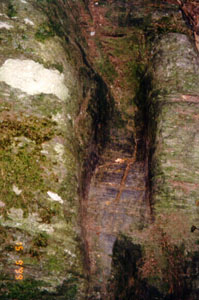 |
|
St. David (Dewi sant) is the patron saint of Wales and the only Welsh saint to be canonized in the Roman Church. The cult of David was centered in Pembrokeshire, from which it spread through south Wales. Few dedications of other proofs of his cult are to be found in the north. His status as patron of Wales dates from the twelfth century. David was known in his day as Aquaticus, the Waterman, due to the numbers of people he baptized or converted to Christianity and also to his asceticism, which kept him from consuming alcohol. The earliest life of David dates from 1088-1096, and was written by Rhygyfarch, the son of a Bishop of St. David's. Rhygyfarch wrote the life to further Welsh independence from Canterbury, and much of it must be regarded as propaganda. According to legend, he was born in 560 C.E. to Sant and Non, the granddaughter of King Brychan of Brecknock. She gave birth to him during a fierce storm, yet the sun shone on the location of his birth and the church provided warmth and shelter. He was baptized in Porthclais, where a spring had miraculously appeared for the event. A drop splashed into the eyes of he blind monk Movi who held him, and the monk's eyesight was restored. David was educated in Hen Vynyw by St. Peulin, whose eyesight was also restored by David's intercession. He also studied on an island under Paulinus the Scribe. David was ordained, and founded twelve monasteries, including Glastonbury, Menevia, and a monastery where the cathedral now stands. Boia, a local Irish chieftain, opposed the foundation of St. David's, but was eventually converted along with his entire family to Christianity through acquaintance with St. David. His fame as an ascetic spread; according to legends, he immersed himself in cold water and performed other feats of ascetic heroism. He preached at the Synod of Brevi where, according to legends, he was acclaimed archbishop of Wales. At that same event, the Synod proclaimed that whoever was abbot of the monastery of St. David's would also be archbishop. Although this account must be regarded as spurious, the power of David's cult did indeed make the bishops of St. David's very powerful, as can be seen from size of the bishop's palace (consult the link below). According to legend, St. David foretold his own death in 589 C.E. (or 601 C.E.) When he died, he told his fellow monks "Do the little things that you have heard and seen through me." So important a saint was David that Pope Calistus II in 1220 declared that two pilgrimages to St. David's equaled one to Rome in the Middle Ages. St. David's was on the road to Ireland, which lay to the west, and was visited by many important kings and nobles who stayed at the Bishop's Palace. The English Kings William I and Henry II both made pilgrimages to St. David's. Shakespeare mentions the Welsh custom of wearing leeks or daffodils on St. David's day; no one knows the origin of this tradition. The colloquial word for someone who is Welsh is "Taffy," which originates from the spelling of David's name as "Dafyd." References:Primary Sources:J. W. James, ed.. Rhygyfarch's Life of David in Latin and English (1967); also found in C. Hortsman, ed. Nova Legenda Angliae (1901) and in A. W. Wade-Evans, Vitae Sanctorum Britanniae et Geneaologiae (1944). Secondary Sources:E.G. Bowen. The Settlement of the Celtic Saints in Wales (1956) C.N.L. Brooke. "The Archbishops of St. David's, Llandaff and Carleon-on-Usk." N,K. Chadwick, ed. Studies in the Early British Church (1958) P. Grossjean. "Notes d'hagiographie celtique." Analecta Bollandiana LXXV (1957), 413-418. S.M. Harris. St. David in the Liturgy (1940) ----- "Was St. David ever canonized?" Wales (June 1944) W. Morgan. Catalogue of Manuscripts, Book Engravings etc. Relating to St. David's (1927)
Pictorial Tour of St. David's and Associated Sites
The Gate that guards the entrance to St. David's Tomb of Geraldis Cambrensis (Gerald of Wales) Return to the Celtic Monasticism: Index or return to Celtic Monasticism: Pilgrimage Links for further explorationThis site has a very nice pictorial tour, with pictures of the interior of the cathedral. To return to the medieval monasticim home page, click here. To return to the virtual tours page, click here.
|
 This is the beautiful
St. David's cathedral in Wales. The floor of the nave actually slopes
downward, so that water pours from the doors. There is also visible
shifting of the pillars. As it is not allowed to take photos in the
cathedral without permission, I have no photo of the nave.
This is the beautiful
St. David's cathedral in Wales. The floor of the nave actually slopes
downward, so that water pours from the doors. There is also visible
shifting of the pillars. As it is not allowed to take photos in the
cathedral without permission, I have no photo of the nave. The cathedral from
below.
The cathedral from
below. The Pilgrim's Road to
St. David's in Wales is a fifteen mile stretch along the cliffs of the
sea, where many pilgrim's left their imprints along the way. You can
see part of the path here along the right side of the photo.
The Pilgrim's Road to
St. David's in Wales is a fifteen mile stretch along the cliffs of the
sea, where many pilgrim's left their imprints along the way. You can
see part of the path here along the right side of the photo.  Here is a view of the cliffs,
very near St. Non's Well.
Here is a view of the cliffs,
very near St. Non's Well.  At the last stop in Nevern
before reaching St. David's, pilgrims carved imprints of their shoes
in stone with crosses,
At the last stop in Nevern
before reaching St. David's, pilgrims carved imprints of their shoes
in stone with crosses,  or tiny incised crosses.
These poignant symbols remind us of the presence of those in the past
who believed the pilgrimage was something important enough to stop everything
for, to give up everything to obtain. You may also want to explore the
or tiny incised crosses.
These poignant symbols remind us of the presence of those in the past
who believed the pilgrimage was something important enough to stop everything
for, to give up everything to obtain. You may also want to explore the
